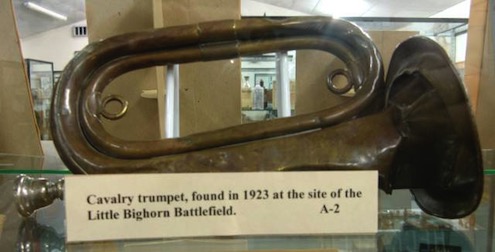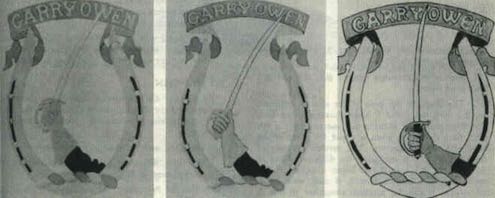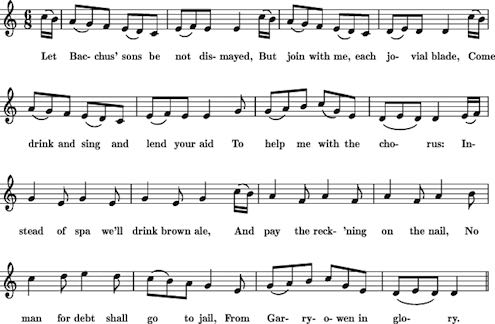Garry Owen, la marcia del 7° Cavalleria di Custer

Il 7° Cavalleria alla carica accompagnato dalle note di Garry Owen
La famosissima marcetta che accompagna l’incedere e la carica del 7° Cavalleria guidato dal “Generale” Custer è così famosa che anche chi non ne conosce neppure il titolo, certamente ne conosce la melodia.
Eppure la storia di questa marcia è particolare e antica, assolutamente indipendente – almeno in origine – dalle scelte di Custer.
Garry Owen (il giardino di Garry), conosciuta anche come Garryowen, Garyowen, Garyone e Gary Owens, è il titolo di una antica melodia irlandese che accompagnava una danza “quickstep”.
Suggerita a Custer da un suo Capitano, Garry Owen fu approvata e quindi suonata per la prima volta dal direttore Felix Vinatieri, italiano, garibaldino, veterano delle guerre risorgimentali e uno dei sopravvissuti di Little Big Horn.
Il 7° fu istituito nel 1866 per condurre le guerre indiane, dieci anni dopo fu sciolto e successivamente ricostituito; le sue battaglie principali furono Washita, Little Big Horn e Wounded Knee, l’ultima delle Guerre Indiane.
In Italia, il vocabolo Garryowen si lega all’Ulisse di James Joyce, in cui figura l’omonimo “personaggio” del cagnaccio del Cittadino.

Le origini di Garry Owen sono poco chiare, ma apparve nel XVIII secolo, come canto di ricchi gaudenti in Limerick (attuale Repubblica d’Irlanda).
Divenne subito “di moda” nell’Esercito inglese, grazie al 5th Royal Irish Lancers, di stanza a Limerick, costituendo una sorta di colonna sonora ante litteram delle guerre napoleoniche, e venendo pure adottata quale marcia reggimentale ufficiale dal 18° Fanteria.
Un primissimo riferimento al brano musicale può rinvenirsi nel Duke of Wellington di Jocquim Hayward Stocqueler, pubblicato nel 1853. Descrive la difesa della città di Tarifa (dicembre 1811) nell’ambito della Guerra peninsulare. Il generale Hugh Gough al comando dell’87º Reggimento (all’epoca famoso come Royal Irish Fusiliers), dopo aver respinto un attacco dei granatieri francesi: «…non gli bastava aver semplicemente resistito. Quando il nemico, sbaragliato, si diede alla fuga, sguainò la spada, comandò che la banda intonasse Garry Owen ed inseguì i fuggitivi per due o trecento yards.»
Garryowen fu anche un inno di successo nella Guerra di Crimea. È stato associato ad una quantità di unità militari britanniche, ed è la marcia d’ordinanza dell’ Irish Regiment of Canada.

Era la marcia reggimentale del Liverpool Irish. È la marcia reggimentale del London Irish Rifles. È stato la marcia reggimentale del 50° Fanteria (The Queen’s Own) fino al 1869.
Divenne in seguito la marcia del 69° Reggimento di Fanteria degli Stati Uniti, (New York Militia), a metà Ottocento. Questa adozione, avvenuta prima della Guerra di secessione americana, è stata riconfermata nell’uso durante la Guerra in Iraq. Dal 1867 è divenuto la marcia del 7° Reggimento di Cavalleria. Era particolarmente gradito al generale George Armstrong Custer, e la leggenda vuole che sia stato l’ultimo “pezzo” eseguito dalla banda militare prima della Battaglia del Little Big Horn.
Il nome del brano è ormai parte integrante del reggimento: le parole Garry Owen si leggono sul relativo stemma e c’è un Camp Garry Owen, a nord di Seul, (Corea), che ospita una parte del 4° squadrone del reggimento di cui parliamo.
Esiste un’incisione discografica del 1993 per opera della Civil War Music Company, banda d’archi del 97º Reggimento. Garry Owen è anche la marcia d’ordinanza della 1° Divisione di Cavalleria.
Il testo della marcia adattata per il 7° Cavalleria:
We are the pride of the army,
And a regiment of great renown,
Our name’s on the pages of history,
From sixty six on down.
If you think we stop or falter,
While into the fray we’re goin’
Just watch the step with our heads erect
When our band plays “Garry Owen.”
Coro:
In the Fighting Seventh’s the place for me.
It’s the cream of all the cavalry;
No other regiment ever can claim
It’s pride, honor, glory, and undying fame.
We know no fear when stern duty
Calls us far away from home,
Our country’s flag shall sagely o’er us wave,
No matter where we roam.
T’is the gallant Seventh Cavalry,
It matters not where we’re goin’
such you’ll surely say as we march away,
When our band plays “Garry Owen.”
(Coro)
Then hurrah for our brave commanders!
Who lead us into the fight.
We’ll do or die in our country’s cause.
And battle for the right.
And when the war is o’er
And to our home we’re goin’
Just watch the step, with our head erect,
When our band plays, “Garry Owen.”

Il testo originale:
Let Bacchus’ sons be not dismayed
But join with me, each jovial blade
Come, drink and sing and lend your aid
To help me with the chorus:
Coro
Instead of spa, we’ll drink brown ale
And pay the reckoning on the nail;
No man for debt shall go to jail
From Garryowen in glory.
We’ll beat the bailiffs out of fun,
We’ll make the mayor and sheriffs run
We are the boys no man dares dun
If he regards a whole skin.(Coro)
Our hearts so stout have got no fame
For soon ‘tis known from whence we came
Where’er we go they fear the name
Of Garryowen in glory. (Coro)
We’ll beat the bailiffs out of fun,
we’ll make the mayor and sheriffs run,
we are the boys no man dare dun,
if he regards a whole skin. (Coro)
Our hearts so stout have got us fame,
for soon ‘tis known from whence we came,
where’re we go they dread the name,
of Garry Owen in glory. (Coro)
Tra le tante pellicole dedicate al suo personaggio c’è La storia del generale Custer (They Died with Their Boots On), un film del 1941 diretto da Raoul Walsh interpretato da Errol Flynn e Olivia de Havilland, in cui si mostra come Custer adottò Garry Owen per il 7° Cavalleria.
Versione cantata:
